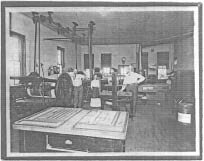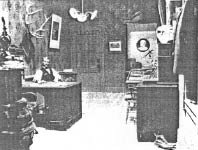
Discover rewarding casino experiences. 
|
The Allemong family, doubtless, lived in the building also. A note here and there in the Gazette might say folks interested would meet at the “observatory” on the roof, presumably to star gaze. The aging Mr. Allemong left to go to Indianapolis where in quite recent years the name was in that city’s phone book! Nephews took over the business. Notice in the weekly stated that F.A. Redline had a music store at the site, 1900. With no iPods, video, television, radio, etc., entertainment was self-induced with instruments of all kinds, the piano being the most popular. Peter’s Brothers Music Store being just one in town, C. 1900. Pictures show the store crowded with pianos of all kinds, even the street was lined with them. Sheet music of all kinds lined racks. Bert Peters took over the business as the brothers aged. Bert was married to my dad’s cousin, Lucille Zuck, and they had two children, one being my cousin Kenny, as we called him. We often played together in the small backyard of the old building. As WWII approached, the Peters’ moved to Rockford where jobs were by the dozens, this the early 1940’s where Kenny still lives though deep into Alzheimer’s disease so he can’t fill in the details as he’d normally love to do. He loved his one-time hometown. With the music business defunct anyway, Bert’s mother, Ella Giddings fitted a “Style Shop” selling ladies clothing, lingerie, jewelry, accessories and such. She actually had some stylish fashions. Through a little door at the north wall was a small lean-to like building, a shanty really, in which at some time the Schultz sisters had a hat shop. They lived up on Eby’s Hill in a big Victorian, built by a one-armed Civil War veteran!
Mrs. Giddings lived upstairs, sometimes with a sister, in an apartment at the rear of the building. My great aunt, Lottie Boyle, lived in a front apartment as tidy as could be. Daughter number one and I would regularly visit her so were well acquainted with the building during the opening years of the 1960’s at which time Elmer Kaufman had a Plumbing fixtures store in the downstairs rooms. You passed through them to go upstairs. By 1961 it also served as Lanark’s Centennial Headquarters a picture will show. By that time, too, the former hat shop was serving as an office for the correspondent of the Lanark Gazette, that business having been sold several years previously. That “lean-to” was about six feet across and perhaps eight feet in length with a slanting ceiling . . . Room only for a desk and a couple of chairs. There were deep shelves above the desk for the large hardbound back issues of the Gazette through which the correspondent and her friends would often pore for anecdotes of the yesteryear. A door on the east wall opened to the street. None of the “local advisors” recall a narrow passageway between it and the “Truman” building to the backyard. There were a number of correspondents over the years, Bea Vietmeier being the last we recall, but previously Margaret Engelking ended the downtown office by taking the issues home where some, at least, rested following her demise. That is the connection of the west side building with the Gazette,, not as the print shop ever but as a correspondent’s stop where people could drop off ads, event notices or who visited whom. Meanwhile, a rich and deep panoply of drama passed up and down Broad Street. Even the superficial and dull could make news! The Gazette covered it all. The “Lanark News” which didn’t last long, only eight years, became part of the Gazette for about four months. Its apartment above or part of Tallman’s Jewelry may still be viewed as display cases in the “Truman building,” now the Appel’s “Treasure Hunt.” Those ornate, Victorian style cupboards with the “T” in their upper middle once stood in Tallman’s Jewelry as illustrated in the 1901 book of residence, commercial and exteriors of Lanark that year . . . the “T” was for Tallman, not Truman.
By 1892 Wild and Barklow had taken on the Gazette, a partnership that lasted a year so that W.G. Wild solely had it after that, actually for the next forty years a trend not common what with all its short term editors or partners. In 1933 Mr. Wild sold to E.Y. Knapp because of his declining health. He died in 1936. Rev. Knapp, a Methodist minister, had the Gazette until 1947, preaching only infrequently although he’d had the local pastorate 1913 to 1919. His shock of white hair was an identifying feature. Ascending the long flight of stairs to the Gazette office with my dad, seeing Rev. Knapp sitting behind the desk is a real memory though it was a long time ago! Peering through the office door into the back shop to see those big presses was awesome in comparison to the small job presses that were more familiar. My great aunt Lottie Boyle worked there for years so she was privy to a lot of local news, some printed, some not, and I should have paid much more attention to the stories she told. What a wealth of history she knew. W.G. Wild’s grandson, Harold Wilson, grew up in the print shop and though well-traveled in the Air Force (he became a colonel), he always had a soft spot for his hometown, jotting off notes to be printed of a memory or visiting now and then. He donated the large stone memorial rock now standing in the Memorial Circle in the cemetery that lists names of World War I veterans. Years ago he remarked that he assembled weeks and years of the “We Like to Remember” columns from back issues of the Gazette which highlighted events and people from 1870’s to the 1930’s. Fun to read and valuable if searching for something key. In August of 1947 Emmanuel Knapp sold the Gazette to Hazel Stagg. Foster Stagg had bought the Thomson Review in 1920, adding then Chadwick, Erie and Hinsdale Reviews. Foster died in 1942 and Hazel, his wife, took over the Review Publications with the assistance of their two sons, Gilpin and Richard, who took on the many duties of the newspaper trade. By 1967 the Stagg’s sold to Kenneth and Jonathan Whitney. Kenneth Whitney had variously been editor of the Thomson and Chadwick Reviews 1934 and 1937, respectively. The Stagg’s had also incorporated the Shannon Reporter, then the Lanark Gazette with the others so the new title became the “Carroll County Review” in April of 1970. Kenneth died in 1988 and Jonathan Whitney became editor/publisher and has remained such until today. It’s rather amazing how many people have been involved in the evolution of just one business in the county in nearly one hundred fifty years. And how it has influenced the development and progress of the area. We began with John Howlett because he has been our “pet” for a number of years and in our perspective had a very interesting character . . . But that’s our perspective. You might have another. And who knows what else might crop up to tell us more. Each editor has been interesting to know on our brief meeting. It came to us in searching and compiling that a story could also be written about Lanark’s first lawyer (but not right away!) Maybe it’s too grisly to be put into a family newspaper because it contains eyewitness to murder, mutilation, torture, slavery, Congressional malfeasance, robbery, and . . . But that, of course, isn’t news. We have that in today’s papers.
|






